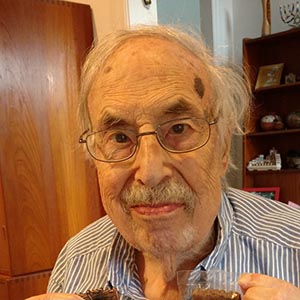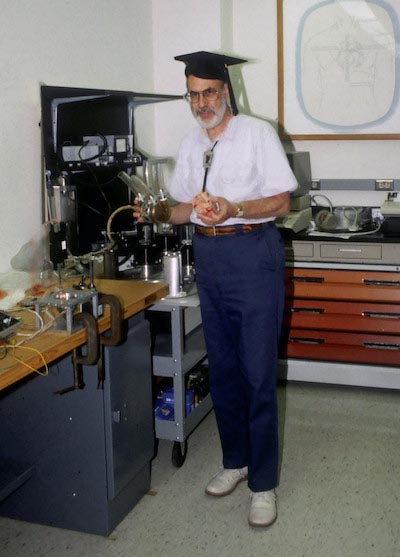David Geselowitz, who contributed to artificial heart development, dies
9/24/2020
By Jamie Oberdick
UNIVERSITY PARK, Pa. — Penn State faculty, staff and students are mourning the loss of David Geselowitz, distinguished alumni professor emeritus of bioengineering and professor emeritus of medicine, who died on Aug. 22 at age 90. He was known for his contributions to the theory of the electrocardiogram (ECG) and the development of the artificial heart.
“When David Geselowitz came to Penn State, he had already established an international reputation as an expert in electrocardiology,” said Roger Gaumond, retired bioengineering faculty member at Penn State. “His partnership with cardiothoracic surgeon Dr. William Pierce of Penn State Health Milton S. Hershey Medical Center led to decades of significant developments in the design and improvements of cardiovascular assist systems and the Penn State Artificial Heart.”
Born in Philadelphia in 1930, Geselowitz graduated from Central High School and the University of Pennsylvania, where he received his bachelor’s, master’s and doctoral degrees in electrical engineering. As the top student in his undergraduate class, he received the Atwater Kent Award.
Geselowitz made an impact early in his career with his doctoral dissertation, which focused on theoretical approaches to measure electrical changes in the heart via sensors on the skin. A paper reporting this work was cited so often in science and engineering literature it was identified as a Science Citation Classic by the Science Citation Index.
After graduating with his doctorate degree, Geselowitz joined the University of Pennsylvania faculty and founded one of the nation’s first doctoral programs in biomedical engineering. In 1971, he moved to Penn State to implement a pioneering graduate program in bioengineering. In 1974, the program was launched under Geselowitz’s leadership and became the University’s first Intercollege Graduate Degree Program (IGDP), with faculty from the Colleges of Engineering, Medicine, Science and Health and Human Development.
“David exemplified the meaning of bioengineering at a time when the discipline was barely defined,” said William Weiss, Penn State professor of surgery and biomedical engineering. “He brought rigorous engineering analysis to the field of cardiology and laid the groundwork for modern clinical practice. He was also an excellent teacher and mentor, always open to questions and discussion.”
In collaboration with then-Penn State bioengineering graduate student Walter T. Miller, Geselowitz developed the Miller-Geselowitz model. The model relates electrical cardiac cell signals to ECG measurements, indicating normal or abnormal heart activity.
Geselowitz also developed the theory for magnetic fields generated by the heart and brain, used extensively by researchers in magnetocardiography, which measures the magnetic fields produced by electrical currents in the heart, and magnetoencephalography, which records magnetic fields produced by electrical currents in the brain. He also contributed to the theory behind impedance plethysmography, which uses electrical resistance measurements to visualize internal structures in the body.
Working closely with principal investigator Pierce, a surgeon at the Milton S. Hershey Medical Center, Geselowitz supervised the development of an artificial heart. In 1976, to international acclaim, a pneumatic left ventricular assist device was successfully implanted in a human patient. It was the first successful procedure of its kind. Still used today, the device helps keep patients alive until a heart transplant can be performed. This technology eventually evolved into a full artificial heart, which is still being developed at Penn State today.
“The artificial heart research has been the landmark of Penn State bioengineering and the IGDP bioengineering graduate program was the foundation of our current Department of Biomedical Engineering, established in 2000,” said Cheng Dong, head of the Penn State Department of Biomedical Engineering. “Dr. Geselowitz was elected to a member of the National Academy of Engineering in a recognition of his outstanding contributions of engineering theory and technology to electrocardiographic fundamentals and diagnoses, which is such a great honor. He will be greatly missed by everyone in Penn State biomedical engineering and beyond.”
In addition to Geselowitz’s election to the National Academy of Engineering in 1989, he also served on numerous panels of the National Institutes of Health and the National Science Foundation to evaluate research grant proposals. He was a founding member and former director of the Biomedical Engineering Society and a co-founder of the International Society for Computerized Electrophysiology. He was one of the first three engineers elected as a fellow of the American College of Cardiology. He was also a fellow of the Institute of Electrical and Electronic Engineers (IEEE), as well as the American Association for the Advancement of Science. He received the Career Achievement Award from the IEEE Engineering in Medicine and Biology Society in 1985 and the Ragnar Granit Prize for contributions to bioelectromagnetism in 2005.
Geselowitz authored more than 150 papers, which have been cited more than 1,400 times in research literature, and he edited one book. He was the editor of the journal IEEE Transactions on Biomedical Engineering from 1967 to 1972, doubling the number of pages published annually and enabling the journal to gain a reputation as a leading publication in the field. He also served on the editorial board of four other journals.
Geselowitz’s contributions to engineering education include supervising 11 doctoral students, four of whom later served as university departmental chairs. He also served as an external member of a number of doctoral defenses, including ones in Finland, Sweden and Canada. He served as a visiting professor at the Massachusetts Institute of Technology, Duke University, the University of Oklahoma and the University of New Mexico.
“Dave was the consummate gentleman,” said Keefe Manning, associate dean of Penn State’s Schreyer Honors College and professor of biomedical engineering. “I asked him to provide lectures in my artificial organs class, and the students were so excited to hear him talk and learn about pacemakers and their evolution over time.”
Outside of academia, Geselowitz was actively involved in the development of standards for ECGs and electric safety in medical instruments as the first non-physician chairman of the Committee on Electrocardiography of the American Heart Association. He served on the Cardiovascular Devices Panel of the Food and Drug Administration from 1983 to 1988, reviewing medical devices for clinical use.
He was also known for his collegial support.
“During the time we overlapped at Penn State, Dave took pleasure in seeing our program grow and the field of bioengineering blossom,” said Herbert Lipowsky, Penn State professor emeritus of biomedical engineering. “In spite of the more vocational aspects of our developing undergraduate program, he always sought to think of our mission as a lofty academic pursuit. And he did so with a sense of pride, that we were standing upon his shoulders, and with a sense of humor.”
Gerson Rosenberg, professor of surgery and bioengineering and chief of the College of Medicine's Division of Applied Biomedical Engineering, said Geselowitz’s kindness stood out.
“He had a very profound impact on so many students and faculty; he was an outstanding mentor,” Rosenberg said. “He was a very kind, polite and caring person who always treated everyone with great respect. When I first joined the faculty at Penn State, he made me feel genuinely welcome. David was also a great collaborator on our research. I think of him most as a very kind and caring person dedicated to education and research.”
Geselowitz also found time for his community. He was a member and served on the board of Congregation B’rith Shalom in State College. He also served on the board of the Penn State University Park chapter of Hillel: The Foundation for Jewish Campus Life and volunteered at Centre Volunteers in Medicine, aiding the medically underserved population in Centre County.
Geselowitz is survived by his wife Lola Geselowitz; sister Judy Gordon; son Daniel Geselowitz and his wife Sandra Cohen; son Michael Geselowitz and his wife Emily Schneider; and son Ari Geselowitz and his wife Bettina Welz. He is also survived by seven grandchildren and three great-grandchildren.
Memorial contributions in his name can be made to the American Heart Association.





